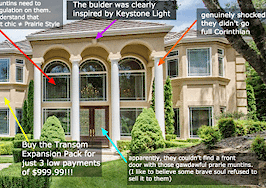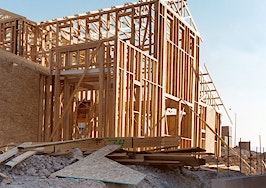The word consumption doesn’t always have a positive connotation; it usually refers to purchasing, or taking over.
And at a panel discussion on October 11th at New York’s International Center of Photography, entitled the “The Architecture of Consumption,” the situation did not improve for those eleven letters. For the panelists—writer Kyle Chayka, McMansion Hell blogger Kate Wagner, and photographer Brian Ulrich—consumption seemed to be about wealth: what wealth can get you, and how we want to be seen.
How we choose to consume architecture says a lot about us. In fact, it says everything.
The unbearable sadness of McMansions
Wagner’s cult hit, controversial blog McMansion Hell pokes fun at the giant, character-less abodes that fill American suburbia, using comedic annotations on listing photos. She made the clearest—and funniest—arguments: that the owners of these McMansions are more interested in having a lot than actually using what they have, and that these homes, with their multitude of rooms, tend to separate family members, not bring them together.
One especially memorable moment in her talk consisted of her juxtaposing two photos: one of a McMansion in Monmouth County, New Jersey, and one of a department store. The buildings, both of which featured a giant arch over their front entrance, looked eerily similar.

McMansion Hell presentation slide. Credit: McMansion Hell
Wagner also compared two five-bedroom houses, one from 1915 and one from the early 2000s. The 20th century home, of course, lacked some of the amenities of the more modern structure: a gameroom, a parking courtyard, a master suite. Wagner referred to this as the “Checklist Effect”: writing down anything you want and then getting it. The ultimate act of consumption, perhaps.
The faux modesty of minimalism
Chayka made many of the same arguments, but while looking at another extreme way of living: minimalism. Chayka began by musing about the Danish magazine Kinfolk, which people tend to photograph in their homes in the sparest of ways: on a table with, perhaps, a notebook, a plant, and a latte.
This led him to thoughts of the modern coffee shop—all succulents and “minimalist stools”—and Airbnb, whose offerings can be lacking in personality or even any identifying traits at all. These three ideas—the Kinfolk photos, the coffee shops, and the Airbnb style—project a “weird blankness” for Chayka, which he views as consumption, too, albeit from the other side.
Chayka said he feels it’s all a show; people on this end of things want others to see how little they have. And it’s all due to technology, he says. Apps direct you to the same kinds of coffee shops, the same types of Airbnbs. He calls this phenomenon “AirSpace,” or “the spread of standardized aesthetic experiences through algorithmic digital platforms and physical spaces.”
And Chayka sees it in relation to class: only the richest among us can afford to have nothing, allowing apps to whisk them through their days. “Absence of stuff = absence of identity = maximum freedom” reads one of Chayka’s slides, but he didn’t seem particularly enthused about that feeling of liberation.
A person’s home is his or her castle?
Ulrich’s portion focused on a theme closer to Wagner’s than Chayka’s: “modern domestic castles” and the people who live in them by choice. The photographer wondered what one is “fortifying against” when they move into an actual castle in 2017, and one could argue that it’s the same thing McMansion owners and serial Airbnb-ers are putting on a show for: the outside world.
The message of the night was clear: in terms of architecture, we want to impress or hide, but never reveal our true selves. In an open part of the event, Chayka related to Wagner that he sensed a “sincerity” in wanting a McMansion and all that comes with it. He may be right, but the overarching idea at this event was obstruction, not openness.











